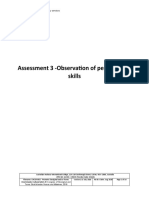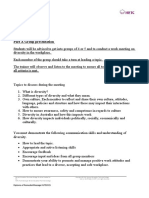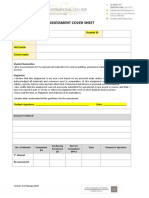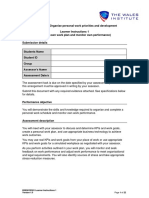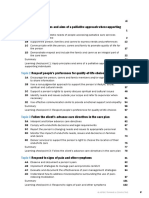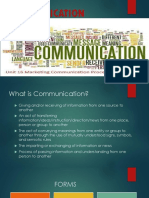Work-With-Diverse-People Answers
Work-With-Diverse-People Answers
Uploaded by
Jaspreet kaurCopyright:
Available Formats
Work-With-Diverse-People Answers
Work-With-Diverse-People Answers
Uploaded by
Jaspreet kaurOriginal Description:
Original Title
Copyright
Available Formats
Share this document
Did you find this document useful?
Is this content inappropriate?
Copyright:
Available Formats
Work-With-Diverse-People Answers
Work-With-Diverse-People Answers
Uploaded by
Jaspreet kaurCopyright:
Available Formats
lOMoARcPSD|8216112
WORK WITH Diverse People
certificate iii in individual care (Melbourne City College Australia )
StuDocu is not sponsored or endorsed by any college or university
Downloaded by Jaspreet kaur (jsprtkaur86@gmail.com)
lOMoARcPSD|8216112
WORK WITH DIVERSE PEOPLE (CHCDIV001)
Student Name Sadikshya Humagain
Student ID No. MEL000019J
I declare that the work submitted is my own and has not been copied or plagiarized from any
person or source.
Student signature Date 11/05/2020
Answers
1.
a.
The social and cultural perspective are that in my culture we visit temple we do not eat beef
as we respect them as god and respect our parents and usually obey what they tell us. So,
for me I still do not eat beef and get shocked when people in foreign country leave their
parent home when they are 16 and work on their own, which is new to me. Therefore, due to
my Asian background and the way I was brought up there is a thought process that makes
me feel like my culture is the best. Due to being brought up in such society and background I
had biases like this but now I get to interact with people here and slowly my biases are
fading away and I am equally receptive to culture here in Australia.
b.
The main limitations to self and social awareness are majorly due to illusion and lack of
proper information. If someone is misinformed and they don't have easy access the kind of
information that guides them in right direction. Then, they are likely to have a limitation to
self-awareness. Likewise, not keeping yourself updated about the changes that occurs in a
society are also like to cause limitation.
c.
I will improve self and social awareness by are recognizing the circumstances in which I'm
likely to limit my self and social awareness. So, I would also pay attention to various scenario
around me and get myself updated with the scenarios that are around me and try to obtain
more information from reliable source. Likewise, if I have any confusion regarding it I will
Downloaded by Jaspreet kaur (jsprtkaur86@gmail.com)
lOMoARcPSD|8216112
ask the related person to clarify me and I will also try to develop my understanding and keep
my mind open to changes.
2.
a.
I will value and respect diversity and inclusiveness across all areas of my work by:
Trying to understand their culture give respect to them.
Respecting the diversity that we have and treating them equally without any biases.
Diversity means many people from different culture, background, ethnicity which will
provide different dimension to the problem solving with different minds.
Inclusion allows people to feel equally important boosting their confidence and
morale.
It will also provide an opportunity to learn various things from each person and
develop our skill and attributes.
b.
I would contribute to the development of work place and professional relationship based on
appreciation of diversity and inclusiveness by:
By being aware of unconscious bias that I could commit in my workplace.
By attending diversity and inclusion training because it will help me understand how
cultural difference can impact how people in my work.
Acknowledging festivals and cultural practices of all cultures and respect them.
Making it easy for people to participate in employee resource groups.
Giving equal importance to all colleagues regardless of their ethnicity, background,
gender and culture and not judging them.
c.
Wearing proper PPE as and when required to ensure safety.
Communicate the emergency plan and make sure exists routes are properly
Practice safety rules and general working practices.
Promote health codes and standards by arranging and attending workshops on the
Downloaded by Jaspreet kaur (jsprtkaur86@gmail.com)
lOMoARcPSD|8216112
importance of health a safety and cleanliness.
Promote mental healthiness and practice proper manual handling.
3.
a.
We can show respect for diversity in communication with all the people by:
talking and communicating in common language English
by avoiding the use of offensive language
by avoiding stereotyping
becoming a good listener
b.
Verbal communication
maintaining voice tone
maintaining voice is speed
maintaining voice and volume
speaking language that is common
using popular vocabulary and grammar
using simple and clear language and speaking slowly
Nonverbal communication
Gentle gesture and body language
showing nice facial expression
maintaining proper eye contact
maintaining distance and respect their personal
Downloaded by Jaspreet kaur (jsprtkaur86@gmail.com)
lOMoARcPSD|8216112
c.
They strategies employed when a language barrier exist are as follows
speaking slowly and clearly
maintaining a normal volume
using clear and simple language
employing the use of communication aid
responding appropriately to emotions and repeating yourself
d.
We would seek assistance from interpreters or another person by
consulting with supervisor
referring to the policy of a company for using interpreter services
by contacting other service team for further support if further assistant required.
The issues the issues that may cause communication misunderstandings or other difficulties
are as follows;
a. Cultural ignorance and insensitivity: The lack of cross-cultural experience or cultural
sensitivity may either over if synthesized or underestimate the influence of culture
when working with cultural communities.
b. Lack of awareness of different societal lifestyle practices: The lifestyle that we live in
and some information that we need to know if in case if we are not able to
understand may cause communication misunderstanding.
c. Differences in cultural practices: Some is misunderstanding might be caused due to
cultural practices for example like Temple and church for prayers etc.
d. Differences in perspective of illness and treatment: Cross cultural misunderstanding
happens when client visits doctor or dentists during assessment diagnosis and
treatment process.
Downloaded by Jaspreet kaur (jsprtkaur86@gmail.com)
lOMoARcPSD|8216112
e. Miscommunication and misinterpretation: Miscommunication and misinterpretation is
the other factor for cross cultural misunderstanding and conflict where language
barriers exist.
4.
b.
Difficulties can occur because of poor communication, a lack of patience or because people
make judgements based on their own cultural values. English translation or the use of slang
and colloquialisms can be stressful to people from other cultures. So, can speaking too
quickly or too low or too high a volume, not listening actively, not asking questions, using
offensive body language and gestures and or inappropriate humor. Therefore, because of
this conflict and cause misunderstanding between people from different cultural
backgrounds, which impact on the working environment resulting poor outcome in the
organization.
4.
c.
I could make an effort to sensitively resolve difference, taking account of diversity
considerations by:
By identifying issues that may cause conflict and try to resolve it by talking to each party
in conflict.
By considering cultural differences if difficulties or misunderstandings occur and maintain
calm and patience throughout.
By addressing difficulties with appropriate people and make them clear about their fault
abd help them understand their differences.
5.
It was the time when I had gone for my placement recently for completion of my certificate
in Individual Support. During that time, I had to interact with different resident from various
religion, country and culture. At that time, I was unable to understand some of them as they
were speaking in their native language. It took a lot of time to understand some of them and
with some research and learning few words of their language from online and with the
guidance seniors, workers there I was finally able to understand what they actually meant. It
was really quite challenging to learn the words but with the help of everyone in their I had a
Downloaded by Jaspreet kaur (jsprtkaur86@gmail.com)
lOMoARcPSD|8216112
very good experience in learning new language, and they were respective of their language
and culture and had very good working environment.
6.
It is really important to provide a culturally safe environment, where staff must acknowledge
and respect the diversity of clients and co-workers and adopt work practices so that cultural
needs of co-workers and clients are met. The co-worker and client will be comfortable in
expressing their cultural identity and through this only worker will feel respected and valued
that will ultimately build healthy work relationship.
7.
Diversity means more than just acknowledging or tolerating difference. Diversity is a set of
conscious practices that involves understanding and appreciating interdependence of
humanity cultures and natural environment. In addition, it is practicing mutual respect for
qualities and experience that are different from our own. There is also need to understand
that diversity includes not only ways of being but also ways of knowing or recognizing
personal cultural and institutional discrimination.
8.
Different cultures and community attitudes may impact on people the way of person
conducts their work, their thought process as well as the way they handle the problems and
conflicts that comes in their way. Community and culture play a very vital role in shaping the
attitudes and influence the person’s views, behavior and beliefs. For example, any activity or
act may be normal for one culture but in other culture it might be illegal to do so. Words and
gestures used can impact the way people view things. Being socially aware using
appropriate terminology and avoiding stereotyping will creates cross cultural relationships.
The workplace policies can also influence the way someone conducts themselves in the
workplace, how the organization aims to reach the vision and mission, valuing diversity staff,
and how to work culturally diverse staff, clients and the client’s families.
9.
The four features of diversity in Australia are:
Political
Downloaded by Jaspreet kaur (jsprtkaur86@gmail.com)
lOMoARcPSD|8216112
Social
Economic
Cultural
Due to various cultural, socio-economic, and life-style backgrounds. When people come
from different background, they have different ways of speaking, different habits and different
methods of doing things. When this is embraced in the work environment it will induce new
ideas and creativity that will result in synergic outcome. Likewise, it will create great impact
in economy and boost the economy where people will generate work and development.
10.
It is against the law for anyone to discriminate a person based on their color, race, gender,
age, background and ethnicity. Under the FW ACT, there are a number of remedies and
penalties for adverse action on discriminatory grounds. The maximum penalty for
contravention of the unlawful discrimination protections is $63000 per contravention for a
corporation and $12600 per contravention for an individual. Therefore, it is duty of an
employer to maintain harassment and discrimination free working environment and failure to
do so can result in fines and penalties as per the legislation.
11.
Human rights are those that are based on the principles of dignity, equality and mutual
respect regardless of religion culture. It is usually about being treated fairly and equally. The
Universal Declaration of Human Rights sets out the basic right and freedom that implies to
everyone. All human beings are born free and equal in dignity and rights. The Human rights
includes right to education, right to life, right to work, freedom of expression of interest and
others as well. In relation to workplace and community sector it declares that
1. Everyone has the right to work and favorable conditions of work and to protection against
unemployment.
2. Everyone has the right to equal pay for equal work without discrimination.
3.Rights and responsibilities of workers, employers and clients, including appropriate action
when rights are being infringed or responsibilities not being carried out.
4. Ensure an existence worthy of human dignity and provide by other means of social
protection.
Downloaded by Jaspreet kaur (jsprtkaur86@gmail.com)
lOMoARcPSD|8216112
12.
If there are any human rights are infringed then we can follow following measures:
Make a complaint under the AHRC Act, if there is any human rights infringed.
Make a complaint to the Ministry of health and long-term care also make the organization
manager aware about the situation.
Take the matter seriously enough to address your concerns with or without the support of
your trade union or professional association.
Likewise, we can also make complaint in writing or by speaking to any staff of the home. The
law says that the long-term care home must respond to your complaint within 10 business
days from the date they receive it. The home must let you know what they have done it. It is
important to keep notes about your complaint. In addition, we also need to seek professional
help of a lawyer, who can give proper advice about the further process.
13.
a.
Culture, Race, Ethnicity: Culture has to do with the language, religion and customs that
characterized a particular groups way of life. For example, European and Asian culture have
their own differences in term of language religion and many more.
Ethnicity refers to the national background with which a person is identified.
Race is a social construct that’s often associated with skin color and other physical features,
which can be white or dark and height and so on.
b.
A disability is any continuing condition that restricts everyday activities. Disability can be
related to various aspects such as an intellectual, psychiatric, cognitive, neurological,
sensory or physical impairment or a combination of those impairments. which is permanent
or likely to be permanent.
c.
Religious belief related to mythology, supernatural or spiritual aspects of a religion. Religious
belief is distinct from religious practices or religious behaviors such as people believing in
Hindu and Christian religion has different religious practices.
Downloaded by Jaspreet kaur (jsprtkaur86@gmail.com)
lOMoARcPSD|8216112
Spiritual belief includes the relationship to a superior being and are related to an existential
perspective on life, death, and the nature of reality. Spiritual belief is more of an individual
practice and to do with having a sense of peace and purpose.
d.
Transgender is a person whose sense of personal identity or gender doesn’t correspond to
the sex they were assigned at birth.
Gay is a term that is used to describe a person’s sexuality especially of a men who are
attracted to men in a romantic or emotional sense.
Lesbian is a term that is used for women who prefers a woman to have a romantic and or
sexual orientation.
Intersex is a term that describes people born with any characteristics including
chromosomes, sex hormones, or genitals. For example, a person might be born appearing
to be a female on the outside but have male parts of inside.
e.
Generational refers to the group of individuals that belong to a particular generation. In other
words, it refers to relation or characteristic of all the people born and living at about the same
time collectively. For example: baby boomers generation, millennials and generation z have
same thought process and behavior among them but different if compared with other
generation.
14.
a.
The potential needs of marginalized groups including the protective factors are:
Positive attitude, values and beliefs.
Good physical, mental, spiritual and emotional health.
Downloaded by Jaspreet kaur (jsprtkaur86@gmail.com)
lOMoARcPSD|8216112
Positive self-esteem and good parenting skills
Parental supervision.
Strong and social supports and conflict resolution ability.
b.
The potential needs of marginalized groups including the physical, mental and emotional
health issues/care needs are:
Try to avoid conflict and understand them
Seek out marginalized voices and perspectives.
Educate the community and listen to them carefully.
Provide support to them as and when required.
15.
The discrimination, trauma negative attitude impacts in people, negative attitudes can have
a detrimental effect on people. They will be sad, depressed, and demotivated to perform
their everyday duties or work. Likewise, discrimination make people feel judged, mistreated
against, it’s hard not to feel hurt and angry, which affect their emotional ability. They won’t
put their opinions with fear of receiving further discrimination. In some cases, it can also lead
to suicide.
16.
The workplace that includes diverse racial, religious, and ethnic backgrounds and genders
with varied lifestyles and approaches to life instead of trying to make everyone make
everyone same always prospers. Diversity acknowledges, peoples difference into the way
people communicate and interact. Therefore, in order to support an organization, we can do
it by respecting the differences and makes them work for the organization. In addition, by
allowing and encouraging new ideas and opinion and prepare inclusive environment to work
and also organize various workshop and participating in it to promote organizational
diversity. Other activities include: cross cultural work teams and training, Inclusion policy in
decision making, use of interpreters if required.
17.
Downloaded by Jaspreet kaur (jsprtkaur86@gmail.com)
lOMoARcPSD|8216112
The influences and changing practices in Australia that impact on the diverse communities
that make up Australian society are:
Difficulties in adjusting to the new society such as problem in socializing
Unemployment and low income
Poor health outcomes
Communication and language barriers
Family break down and stereotyping
18.
Dispossession of land and Family break down
Mental health issues along with social and emotional wellbeing issues
Grief and loss issues
Poverty, racism, unemployment and Poor health outcomes
Poor housing standards, Below standard literacy
Alcohol and substance abuse/Misuse
19.
Some of the Aboriginal and Torres Strait Islander groups wish to retain their unique
culture but due to current society condition they are losing their identity.
Many Aboriginal and Torres Strait Islander young people has lost their interest in their
culture resulting discontent and conflict.
Many Aboriginal and Torres Strait Islander people were moved to missions or reserves,
where they were forbidden to speak their own language or maintain their cultural practices in
past days resulting stolen generation and culture.
Many lost their language and cultural identity as they were expected to adopt European
dress, language, religion, lifestyle and cultural values.
Downloaded by Jaspreet kaur (jsprtkaur86@gmail.com)
lOMoARcPSD|8216112
20.
The impact of diversity practices and experiences on others are:
o It helps to find about peoples different backgrounds and skills.
o Enhanced working relation with people.
o An increased ability to be flexible and creative
o Ability to deal effectively within an organization as general community is diverse.
21.
The thoughts of human needs and rights are firmly associated human rights that apply for
each individual. Human needs including the need to have food, cloth, shelter, in an any
environment of satisfactory mental and physical wellbeing; to have security and assurance
from physical harm; to share with friends and family in common respect. Human rights were
made up front with the widespread affirmation of human rights with focused the world's
consideration on moral standards reflected in characteristic rights and in universal law. They
are viewed as rights innate to every single person, and transient religion, ethnic source or
geological area.
22.
Discrimination is defined as distinguishing differences between things or treating someone
as inferior based on ethnicity, sex, nationality, age, or other characteristics. In other words,
discrimination is the prejudicial and/or distinguishing treatment of an individual based on
their actual or perceived membership in a certain group or category, in a way that is more
awful than the manner in which individuals are typically treated.
23.
The three things are mentioned below:
Sustaining awareness of diversity: Provide information on workplace diversity to all
staff and customers who are working in that place, which can be done through formal
training with staff and informative flyers and posters.
Demonstrating commitment to diversity: This can be done by treating others with
respect, courtesy and consideration, demonstrate workplace diversity, support
Downloaded by Jaspreet kaur (jsprtkaur86@gmail.com)
lOMoARcPSD|8216112
flexible working arrangements and recruiting staff based on processes and fair
selection decisions based on merit.
Maintaining a safe and secure work environment: For this organization can give
required support for employees by providing information, teamwork to build an
environment in which everyone can fully participate, be open minded, respond and
listen to the views of others.and also treat others with respect, courtesy and not
tolerating any kind of harassment or discrimination .
24.
The few steps that can be helpful to become culturally competent are as follows:
Personal recognition and acceptance that all types of cultures have equal influence
on our lives.
Personal awareness that oppression is pervasive in our society. It is part of our
history and, as much as we may want to escape that fact, it colours our relationships
The acceptance that there are cultural differences, and we need to learn to respect
what we may not always understand.
Have the humility to accept that we do not know everything about other cultures, and
ever will but we need to ascertain we know about the specific groups with whom we
are working .
A willingness to pursue that information in all of the ways available to us and having
the courage to identify and confront our personal resistance, anger, and especially,
our fears.
25.
Four tips that can be helpful for responding to diversity in work place are as follows:
Developing non-discriminatory attitude
Acknowledging diversity and respect every diverse people and culture
Avoid racial jokes with workers
Try not to offend their cultural practices
26.
Downloaded by Jaspreet kaur (jsprtkaur86@gmail.com)
lOMoARcPSD|8216112
The four key valuing behaviors diversity are listed below:
Finding out about peoples' different backgrounds and skills
Active listening to different viewpoints and perspectives
Treating people as individuals, not as representatives of a group
Creating opportunities to interact with people who are different
27.
The four commonwealth acts which cover discrimination in the workplace are:
o The Racial Discrimination Act 1976
o The Sex Discrimination Act 1984
o The Disability Discrimination Act 1992
o The Human Rights and Equal Opportunity Commission Act 1987
28.
Discrimination in language means that the language is not respectful or accurate in its
references to particular individuals or groups of people. Therefore, when communicating at
work, everyone is obliged to use inclusive language, and avoid stereotypes. The use of
languages such as changing the words to eliminate the generic he by using both male and
female pronounce (that is he/she) or using plurals that is (they) is appropriate in workplace.
29.
Non-verbal communication is the transmission of messages or signals through facial
expressions, gestures and touch. Body language is a type of a non-verbal communication in
which physical behaviors, as opposed to words, are used to express or convey the
information. Such behavior includes facial expressions, body posture, gesture, eye-
movement, touch and the use of space.
30.
The four ways to help overcome the communication difficulties across cultural and
linguistic bond are:
Downloaded by Jaspreet kaur (jsprtkaur86@gmail.com)
lOMoARcPSD|8216112
Maintaining normal volume
Paraphrasing
Using clear and simple language
Responding to emotions appropriately.
31.
Usually in the situation where one has to make decisions regarding their life might use a
professional interpreter when there exists a language barrier, such as:
Care planning
Legal advice
For Medical consultation, in context of changes in medicine or dosage to be taken
For Discussing test to be done and the outcomes.
32.
The four of the issues that may cause conflict in a culturally diverse environment are as
follows:
Derogatory comments
Put-downs and use of Offensive language
Commenting on a person's physical appearance
Ignoring or isolating behaviour
33.
The step that can be respond to cross-cultural conflict in workplace are:
i. Remain calm and try not to be influenced by emotions
ii. Inform the instigator that their behaviours are inappropriate or offensive, but make it
clear that it is their behaviours that you find offensive and not them
iii. If the person involved offers you an apology, accept it If they don’t offer an apology,
let it go once.
iv. However, if same behaviour continues, then proceed to take action.
Downloaded by Jaspreet kaur (jsprtkaur86@gmail.com)
lOMoARcPSD|8216112
v. The parties involved may determine the course of action to be taken as per
organization policy.
34.
Few steps can be followed to deal with complaining clients are:
Listen carefully to what the customer has to say and let them finish as active listening
helps to open up and avoid misunderstandings
Establish nature of complaint by trying to find out the involved person and obtain as much
as information and detail of the complaint.
Take action to resolve complaint to clients satisfaction and you should always offer them a
solution to the problem, and if you cannot directly fix the problem, offer them something else
to try and keep them satisfied, which can be a genuine apology.
Refer the unresolved complaints to supervisor or someone who can solve, such as senior
staff or manager and make sure to inform the person how long the wait will be, or what to
expect and always remember that, it is the little things that make the difference.
Downloaded by Jaspreet kaur (jsprtkaur86@gmail.com)
You might also like
- CHC24015 Certficate II in Active Volunteering Log Book - 201910 V2.7Document28 pagesCHC24015 Certficate II in Active Volunteering Log Book - 201910 V2.7Jayde Archer100% (1)
- HLTWHS006 Assessment 1 Information Sem 2 2019Document5 pagesHLTWHS006 Assessment 1 Information Sem 2 2019Lana RothnieNo ratings yet
- CHCDIV002 Learner Workbook V1.2Document37 pagesCHCDIV002 Learner Workbook V1.2Ashesh BasnetNo ratings yet
- 32476B/P4 Work Placement Portfolio: 1. Background/overviewDocument17 pages32476B/P4 Work Placement Portfolio: 1. Background/overviewtetyanaNo ratings yet
- CHCPRP001 - Roleplay V1.2 - CDocument8 pagesCHCPRP001 - Roleplay V1.2 - CShaneNo ratings yet
- CHCAGE002 Implement Falls Prevention SAB v3.1 THEORYDocument20 pagesCHCAGE002 Implement Falls Prevention SAB v3.1 THEORYAbhishek Dhungel33% (3)
- Financial Freedom Traders PlanDocument18 pagesFinancial Freedom Traders PlanDarryl47100% (1)
- CHCDIV001 AssessBooklet PC V2.0 2018Document30 pagesCHCDIV001 AssessBooklet PC V2.0 2018Alessandra Arcamone50% (2)
- This Study Resource Was: Chcdiv001 - Work With Diverse PeopleDocument9 pagesThis Study Resource Was: Chcdiv001 - Work With Diverse PeopleNidhi GuptaNo ratings yet
- Assessment 011 1Document11 pagesAssessment 011 1ManawNo ratings yet
- SAB CHCDIV001 Work With Diverse People CHCCCS023 Support Independence and WellbeingDocument113 pagesSAB CHCDIV001 Work With Diverse People CHCCCS023 Support Independence and Wellbeingpoonam mahat0% (1)
- CHCDIV001 Assessment Tool V2.1 Jan 2021Document16 pagesCHCDIV001 Assessment Tool V2.1 Jan 2021yESHEy TNo ratings yet
- Assessment Summary / Cover Sheet: Click Here To Enter Text. Click Here To Enter Text. Click Here To Enter TextDocument18 pagesAssessment Summary / Cover Sheet: Click Here To Enter Text. Click Here To Enter Text. Click Here To Enter Textradhika100% (1)
- CHCDIV001 Work With Diverse People: AssessmentDocument4 pagesCHCDIV001 Work With Diverse People: AssessmentUsman DoltanaNo ratings yet
- CHCDIV001 Work With Divese People SAB V3.4Document35 pagesCHCDIV001 Work With Divese People SAB V3.4Abhishek khatriNo ratings yet
- CHCDIV001 Work With Divese People SAB (Ageing) v3.1 - THEORYDocument35 pagesCHCDIV001 Work With Divese People SAB (Ageing) v3.1 - THEORYSujan AdhikariNo ratings yet
- CHC33015-Work in Health and Community services-LG-F-v1.2Document69 pagesCHC33015-Work in Health and Community services-LG-F-v1.2ஆர்த்தி ஆதிNo ratings yet
- CHC33015-DIS-Subject 3-AWB-F-v1.4Document34 pagesCHC33015-DIS-Subject 3-AWB-F-v1.4ஆர்த்தி ஆதி0% (1)
- CHCDIV001 Work With Diverse People and Support IndependenceDocument16 pagesCHCDIV001 Work With Diverse People and Support IndependenceyESHEy TNo ratings yet
- Research Report DIV001Document10 pagesResearch Report DIV001samridhi.bansal89No ratings yet
- CHCDIV002 Assessment 3Document14 pagesCHCDIV002 Assessment 3Anmol PoudelNo ratings yet
- Chcadv001 A4 PDF 11.07.22Document15 pagesChcadv001 A4 PDF 11.07.22Stevie Jane SmithNo ratings yet
- CHCHCS001 Home & Community SupportDocument23 pagesCHCHCS001 Home & Community SupportSibani KarNo ratings yet
- CHCDIV001 Diversity AssessmentDocument10 pagesCHCDIV001 Diversity AssessmentKyu RITANo ratings yet
- Answer 1-CHCHCSOO1 Heavendee (Sekhon D4255Document3 pagesAnswer 1-CHCHCSOO1 Heavendee (Sekhon D4255shweta0% (1)
- CHCPRP001 rg9Document15 pagesCHCPRP001 rg9Rabina Adhikari100% (1)
- Assessment Task 4 - Incident Report and Safety Meeting: HLTWHS002 Follow Safe Work Practices For Direct Care WorkDocument2 pagesAssessment Task 4 - Incident Report and Safety Meeting: HLTWHS002 Follow Safe Work Practices For Direct Care WorkSunita MehmiNo ratings yet
- Assessment Cover Sheet: Student Name Student ID Unit Code Unit Name Course NameDocument35 pagesAssessment Cover Sheet: Student Name Student ID Unit Code Unit Name Course NameSandeep KaurNo ratings yet
- 9 - CHCCOM005 PPSlides V1.0Document123 pages9 - CHCCOM005 PPSlides V1.0Leanne EvansNo ratings yet
- Course Details - CHC32015 Certificate III in Community Services - Mark Oliphant CollegeDocument1 pageCourse Details - CHC32015 Certificate III in Community Services - Mark Oliphant CollegeSaroja ChhetriNo ratings yet
- Chcleg001 Quiz Test AntsDocument11 pagesChcleg001 Quiz Test AntsSandra BuckleyNo ratings yet
- Bsbwor301 Assessment 1Document22 pagesBsbwor301 Assessment 1Farah Adila Binti TalibNo ratings yet
- Student Assessment Booklet: CHC33015 C III IDocument16 pagesStudent Assessment Booklet: CHC33015 C III IYuan De Amadhau0% (2)
- Chcc0m003 Questions Part 1Document11 pagesChcc0m003 Questions Part 1Sandeep KaurNo ratings yet
- CHCAGE001 AssignmentDocument4 pagesCHCAGE001 AssignmentDavid MarkNo ratings yet
- Full Textbook - CHCADV001Document61 pagesFull Textbook - CHCADV001Kabita123 NepzzNo ratings yet
- Work Legally and Ethically: CHCLEG001Document84 pagesWork Legally and Ethically: CHCLEG001ஆர்த்தி ஆதி100% (1)
- Dcs - Hltwhs004 - Task 2 Case Studies.v2.190305Document7 pagesDcs - Hltwhs004 - Task 2 Case Studies.v2.190305Crown HuynhNo ratings yet
- SAB CHCHCS001 Provide Home and Community Support ServicesDocument58 pagesSAB CHCHCS001 Provide Home and Community Support Servicespoonam mahatNo ratings yet
- CHCPAL001 Student Assessment Booklet - AGE (ID 98478)Document49 pagesCHCPAL001 Student Assessment Booklet - AGE (ID 98478)Francis Dave Peralta Bitong50% (2)
- Afshan-Work Legally and Ethically - Written TaskDocument12 pagesAfshan-Work Legally and Ethically - Written TaskAsh Amin50% (2)
- Skills Assessment: CriteriaDocument19 pagesSkills Assessment: CriteriaAzal YounisNo ratings yet
- CHC Implementation Guide Version 4.0 May 2021 FinalDocument241 pagesCHC Implementation Guide Version 4.0 May 2021 FinalAP LiangcoNo ratings yet
- CHCDIV001 Learner Guide V5.1Document48 pagesCHCDIV001 Learner Guide V5.1Akriti Dangol100% (1)
- ThinTea Eating PlanDocument10 pagesThinTea Eating Planpatriciagarciarr100% (1)
- Assessment Summary / Cover Sheet: Student Assessment HLTWHS002 Follow Safe Work Practices For Direct Client CareDocument24 pagesAssessment Summary / Cover Sheet: Student Assessment HLTWHS002 Follow Safe Work Practices For Direct Client CareGurpreet Singh Wirring100% (1)
- E1144 Module2 Assessment3 SAQrubric 32469 03 v2 3 THyde 1 01 04 2020 2159Document25 pagesE1144 Module2 Assessment3 SAQrubric 32469 03 v2 3 THyde 1 01 04 2020 2159tetyana0% (1)
- (CSW) CHCCS411C - Assessment 4-ResubmissionDocument5 pages(CSW) CHCCS411C - Assessment 4-ResubmissionIndy Efu100% (1)
- CHCCCS015 AssignmentDocument25 pagesCHCCCS015 Assignmentprabhjot kaur100% (2)
- Chcccs023 Chccom005 SolutionDocument32 pagesChcccs023 Chccom005 Solutionivahn mutinda0% (1)
- HLTWHS004 - Assessment Task 6 of 7 (Task 1) .v1.0Document2 pagesHLTWHS004 - Assessment Task 6 of 7 (Task 1) .v1.0Reine WenceslaoNo ratings yet
- Int Brochure PDFDocument6 pagesInt Brochure PDFjpanayNo ratings yet
- Topic 1: © Aspire Training & ConsultingDocument20 pagesTopic 1: © Aspire Training & ConsultingMashael SulimanNo ratings yet
- Harpreet Kaur - Andy MarkedDocument56 pagesHarpreet Kaur - Andy Markedks khalsaNo ratings yet
- HLTWHS002 PDFDocument4 pagesHLTWHS002 PDFJase Harrison25% (4)
- Full Textbook - CHCCCS011Document62 pagesFull Textbook - CHCCCS011Kabita123 NepzzNo ratings yet
- Answers - Chcdiv001 Student Assessment. v1. 110520 (For Chc43115)Document37 pagesAnswers - Chcdiv001 Student Assessment. v1. 110520 (For Chc43115)lmravelo100% (1)
- Purposive ComDocument54 pagesPurposive ComjulinaNo ratings yet
- PC Task 1-5Document6 pagesPC Task 1-5Jaya CasianoNo ratings yet
- Basic Practice of Anesthesiology FinalDocument70 pagesBasic Practice of Anesthesiology FinalAfiqah So JasmiNo ratings yet
- Robert Wilson - Guardian InterviewDocument2 pagesRobert Wilson - Guardian InterviewTR119No ratings yet
- Bilateral Political Tension and The Signaling Role of Patenting in A Host CountryDocument12 pagesBilateral Political Tension and The Signaling Role of Patenting in A Host Countrygoncapaulos3No ratings yet
- House Talk Journey 2024 by HDCL Advisory (Johor) Registrant Kit Collective Sessions - Genting Property SDN BHDDocument19 pagesHouse Talk Journey 2024 by HDCL Advisory (Johor) Registrant Kit Collective Sessions - Genting Property SDN BHDPH LeeNo ratings yet
- Court Observation ReportDocument1 pageCourt Observation ReportHongAlex1311No ratings yet
- Second Conditional. Katie Melua If You Were A SailboatDocument2 pagesSecond Conditional. Katie Melua If You Were A SailboatTudosă MădălinaNo ratings yet
- 21st Century Storage Acquires New Property in New YorkDocument2 pages21st Century Storage Acquires New Property in New YorkPR.comNo ratings yet
- Wu - 3rd - Generation - PVDocument12 pagesWu - 3rd - Generation - PVAlvaro Andres Aguilar GoezNo ratings yet
- Bca Java LabDocument18 pagesBca Java LabAnuradha PatnalaNo ratings yet
- Blalock-Taussig (BT) Shunt or Central Shunt UHL Paediatric Intensive Care GuidelineDocument9 pagesBlalock-Taussig (BT) Shunt or Central Shunt UHL Paediatric Intensive Care GuidelineYusra CokoretoNo ratings yet
- Budi Gunawan CaseDocument4 pagesBudi Gunawan CaseRaselya WirsaNo ratings yet
- Accruals & PrepaymentDocument10 pagesAccruals & PrepaymentJessica TseNo ratings yet
- d100 Osr TrapsDocument120 pagesd100 Osr TrapsAlexandre BonnehonNo ratings yet
- ch8 Elastic Tape PDFDocument4 pagesch8 Elastic Tape PDFAMIT PRAJAPATINo ratings yet
- Sentence and Its TypesDocument13 pagesSentence and Its Typesarx9901No ratings yet
- Curriculum Map Health Grade - 7Document6 pagesCurriculum Map Health Grade - 7Shiela Mea BlancheNo ratings yet
- Doty Cornellgrad 0058F 11958Document147 pagesDoty Cornellgrad 0058F 11958HunairaNo ratings yet
- Power of Compounding in Mutual Funds PDFDocument5 pagesPower of Compounding in Mutual Funds PDFVinod NairNo ratings yet
- Ielts Reading Question SheetDocument2 pagesIelts Reading Question SheetShahzeb HaiderNo ratings yet
- Instant Download Test Bank For Fundamentals of Cost Accounting 6th by Lanen PDF All ChapterDocument109 pagesInstant Download Test Bank For Fundamentals of Cost Accounting 6th by Lanen PDF All Chapterlonikuvilija100% (4)
- Educational Resources and Resource CentreDocument14 pagesEducational Resources and Resource CentreGiftlin G. DhasNo ratings yet
- Blockings: Select Text StatusDocument4 pagesBlockings: Select Text StatuskalyanjipandeyNo ratings yet
- Dark Souls 3 Armor Spreadsheet 041916Document18 pagesDark Souls 3 Armor Spreadsheet 041916rognanosenoreNo ratings yet
- Maintenance & Service - I Course Code: 4360201: Page 1 of 12Document12 pagesMaintenance & Service - I Course Code: 4360201: Page 1 of 12Aaqib SurtiNo ratings yet
- DLP English Q4 Week1 - D1Document4 pagesDLP English Q4 Week1 - D1RachelNo ratings yet
- Nature & Creation of Atty-Client RelationshipDocument8 pagesNature & Creation of Atty-Client RelationshipGrachelle AnnNo ratings yet
- Unconfined Compression TestDocument3 pagesUnconfined Compression TestThrisha SoquitosoNo ratings yet
- Working in The Voluntary Sector (Craig Brown) (Z-Library)Document193 pagesWorking in The Voluntary Sector (Craig Brown) (Z-Library)Jonathan FerueloNo ratings yet
- 9th - Biology - 01 - Fundamental Unit of Life - 02 - Tissue - & - 03 - Improvement in Food ResourcesDocument124 pages9th - Biology - 01 - Fundamental Unit of Life - 02 - Tissue - & - 03 - Improvement in Food ResourcesMadhu SatapathyNo ratings yet




















